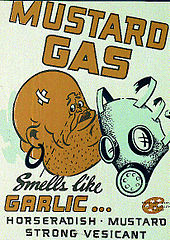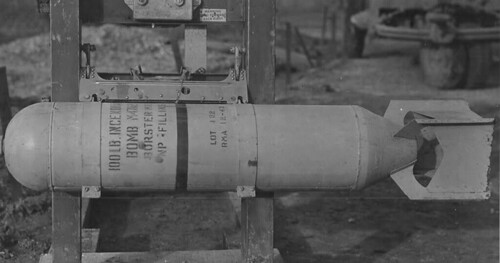The Area

Junkers Ju 88

Readying To Raid
A barbaric compound concocted by French (Cesar-Mansuete Despretz - 1822, Alfred Riche - 1854), British (Frederick Guthrie - 1860, Hans Thatcher Clarke - 1913), and German (Albert Niemann - 1860, Viktor Meyer - 1886, Hermann Emil Fischer - 1913) chemists, the sulfur mustards of warfare infamy are yeloow-brown in color, smell of garlic, mustard, or horseradish, are usually dispersed in a fine mist of liquid droplets that can easily be absorbed by skin and clothes forming large blisters on the skin and lungs that can disable or kill the person that they come in contact with (1st, 2nd, and 3rd degree burns can be caused), its toxic qualities can linger on the ground for days and weeks, and in some long-term circumstances, it can cause cancer to its victims. The war mixture is originally called LOST, for the two German scientists who perfect mass producing the compound, Wilhelm Lommel and Wilhelm Steinkopf. LOST indeed, the weapon is first unleashed in 1917 on British and Canadian troops by the German Army during the Ypres campaign during WWI, then the French also later in 1917, the British and French soon follow suit on the Germans in the attempts to break the Hindenberg Line in 1918. After the war, its use as a weapon is first banned by the Geneva Protocols of 1925 ... protocols that are still in effect when World War II begins.
Gas Attack
Bad Air
Victims

U.S. Army Poster
After successfully taking Sicily from the Germans and forcing the surrender of the Italian government, at the end of 1943, due to Operations Baytown, Avalanche, and Slapstick, Allied forces having landed in southern Italy and begun a campaign north to eventually take Rome ... a push requiring massive amounts of supplies, and with Naples already swamped by the effort, Bari is used too, though its air defenses are slight and fighters within range are usually assigned to offensive forces. But it is thought by Allied leaders in command that the Germans will attack more important targets elsewhere, and hubris hugely on display, on 12/2/1943, Air Marshall Sir Arthur Cunningham states, "I would consider it as a personal insult if the enemy should send so much as one plane over the city." Fate tempted, later that same day the port receives the German's personal insult in the form of not one plane, but 150 Luftwaffe bombers ... undefended below are over thirty ships of American, British, Norwegian, Dutch, and Polish registry ... one is the SS John Harvey.
Bari, Italy

Cunningham Portrait - 1943
Built by the North Carolina Shipbuilding Company in Wilmington, North Carolina and launched in January of 1943, the ship is 441 feet and 6 inches in length, has two oil-fired boilers that can power it up to an average speed of 11 knots, is crewed by 81 officers and sailors, and can carry 504 soldiers into battle. On 12/2/1943 though, commanded by Captain Elwin F. Knowles, instead of soldiers in its holds, it is carrying 2,000 M47A1 mustard gas bombs, each holding 60-70 pounds of sulfur mustard inside, a retaliatory deterrent secretly approved by FDR (the mission is approved in August of 1943) should Nazi Germany decide to break the Geneva Protocols and gas Allied troops. North Carolina to Oran, Algeria and then on to Augusta, Sicily where the bombs aboard are inspected by an officer of the 7th Chemical Ordinance Company, the ship sails through the Strait of Otrando and arrives in Bari in November of 1943. Destination reached, in Bari the ship discovers a port full of other ships waiting to be off-loaded, and so it waits and waits and waits to have its cargo taken ashore (following orders to the letter, the captain has been told to tell no one of his cargo, and so, does not ask for a priority from the harbormaster to get the sulfur mustard to its protected storage destination). Soft defenses and surprise when the Luftwaffe begins its raid at 7:25 in the evening (targets spotted earlier in the day, the raid is put together by Generalfeldmarscall Wolfram von Richtofen (a cousin of the famous Red Baron of WWI fame) and begins with two German aircraft circling the harbor at 10,000 feet and dropping flares to illuminate targets and foil strips to confuse Allied radar).
SS John Harvey

M47A1 Bomb

von Richtofen
A holocaust from the heavens, hit after hit take place on the ships below ... two ammunition ships blow up shattering windows over 7 miles away, a bulk petrol line on a quay is cut and pours burning fuel into the harbor ... in all 28 merchant ships with more than 31,000 tons of cargo are destroyed and 12 more ships are severely damaged (the port will be closed for three weeks and will not be fully operational until February of 1944). Among the destroyed vessels is the SS Harvey, and we she explodes, the captain and every man that knows her secret cargo is killed, so when the mustard gas is released into the air and oil-filled waters of the harbor, no one knows the deadly calamity that is being spread to survivors, rescuers, and the citizens of Bari.
Chaos
Bari Burning
Fighting Fires
After - Bari Harbor
Something seriously wrong beyond the normal victims of a bombing raid, within 24 hours the first symptoms of mustard gas poisoning, blindness and chemical burns, begin appearing in 628 patients and medical staff of the town (caught in the blast from the SS John Harvey, the crews of the destroyers HMS Zetland and HMS Bicester are unable to use their equipment and dock in the port of Taranto several days later) ... and hundreds of civilians begin manifesting symptoms too. The mystery begins to be solved when Deputy Surgeon General Fred Blesse is informed of the situation and orders Lt. Colonel Stewart Francis Alexander, an expert on chemical warfare, to investigate, and the cause is soon traced back to the SS John Harvey, and mustard gas is confirmed to be the agent manifesting at the harbor when trace amounts of the compound are found on a fragment of a U.S. M47A1 bomb casing. Treatment changed to mustard gas poisoning, many lives are saved because of Alexander's identification of the source of the problem. Eventually 83 of the 628 hospitalized military victims die from being poisoned by the mustard gas (and an unknown but larger number of civilians who leave the devastated city without seeking help) ... in all, the raid claims over 2,000 military, merchant, and civilian lives.
Rescue?
Casualty
Blesse
Alexander & Wife
Issue samples kept from autopsied victims, after the war the samples are used to develop one of the first forms of chemotherapy, the drug mustine. But no silver lining is desired by those in command of the situation and almost immediately a curtain descends on the events that have taken place at Bari ... the Allied High Command at first tries to conceal the matter, frightened that the Germans might think a chemical attack is coming there way, and so set one off themselves, but with too many witnesses available to the event, they issue a statement in 1944 admitting to the accident and stating no chemical warfare was planned. General Eisenhower approves Dr. Alexander's work and report on the matter, but Prime Minister Churchill orders all British documents on the attack to be purged and the gas attacks are instead described as "burns due to enemy action." U.S. records of the raid declassified in 1959, the episode is mostly forgotten until the publication in 1967 of author Glenn B. Infield's book, Disater at Bari, and it isn't until 1986 that the British government admits to the gas poisoning and amends its pension payments to survivors of the raid. And in 1988, Dr. Alexander, through the efforts of Nick T. Spark, U.S. Senator Dennis DeConcini, and U.S. Senator Bill Bradley finally is recognized by the Surgeon General of the United States Army for his actions in the aftermath of the Bari tragedy.

A Secret No More
Unbelievable the stupidity of those in charge.
ReplyDelete